Over the last seven weeks we have explored local wildlife that kids may find in their yards. These have been primarily birds and bugs. These are what you can see and find relatively easily. For some, lizards are on the list – others may have frogs. I have lived in this house in Pensacola for 40 years and have only seen one snake.
We do have mammals. We have discussed raccoons and there are opossums. And of course, squirrels and rats (we chose not to speak on rats so far – but probably should). But for the last couple of species for this school year I am going to discuss some that may be nearby and, like snakes, concern people. Today we are going to discuss coyotes.
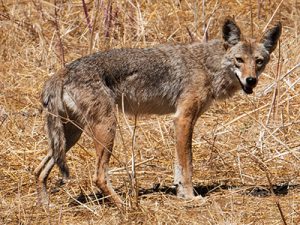
Photo: USDA
In 2015, during the month of February, FWC had six reports of coyotes in the in Pensacola area. Four were coyotes seen (or heard) and two were about coyotes taking a pet and some chickens. I have either seen, or heard about, coyotes in the Perdido Key area, Cantonment, East Hill, Cordova Park, the airport property, Gulf Breeze, Pensacola Beach, and Navarre. I think it is safe to say they are probably everywhere.
Like most local mammals, they move at night and tend to stay out of our way. I remember watching a program on coyotes (in this case their hybrid with wolves called a “coywolf”) showing coyotes roaming the streets of Chicago and no one knowing they were even there. These are smart, stealthy, creatures who prefer to stay out of our way. We only know of their existence from tracks, scat, possibly a lost pet, and you may have seen one on an early morning, or later afternoon walk. We do not seem to have a real problem with them. But it makes many uneasy knowing they are around.
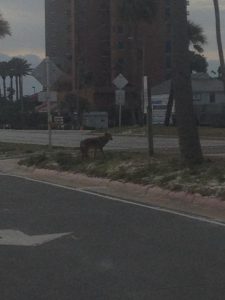
Photo: Lois
Coyotes are members of the dog family. An average coyote in our neck of the woods would about the size of a mid-sized dog – about 35 pounds. They can be a variety of colors and may appear as a larger, heftier fox. They live in dens around the neighborhood and it is amazing how small of a hole they can go into. They usually give birth in winter to six pups and the mom must now feed them. During these times (February and March) there are more encounters with them because of this.
Coyotes usually feed on small rodents. The squirrels and rats we do see more often in our yards, are perfect prey for them. They will take rabbits and birds if the opportunity presents itself. Taking pets is also an opportunistic thing. Small dogs and cats roaming the neighborhood at night are certainly targets, however gut contents of road killed coyotes show they do not eat a lot of them.
Attacks on humans are very rare, almost on heard of in Florida. Most of the cases I read about were in Los Angeles, where they ARE having a problem with them. The study conducted by Ohio State University in the Chicago area shows that many bad encounters with humans are due to the animals being fed by humans. This could be intentionally or unintentionally. All predators seeking prey want to expend as little energy as possible to make a kill. What is easier than eating trash out of a trash can or dog food in a bowl left outside. Once they find these “easy” sources, they will return – and negative encounters can happen.
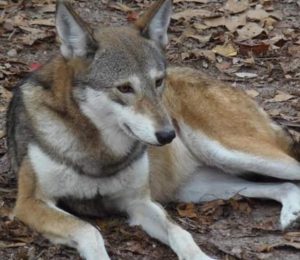
Photo: Molly O’Connor
There is also the issue of sick coyotes. There is evidence of sick individuals approaching homes without regard of humans being outside, and even in the daytime.
Though it may be a bit nerve racking to think about, I don’t think they are going anywhere. There are reports of them in Florida as far back as the 1960s and they are now reported in every county. In California and Colorado there have been removal programs, but they have not been every effective. In every case the coyotes replaced themselves very quickly – in some cases increased their numbers! They have been able to survive after 70% of them have been removed from an area.
The safe thing to do is (a) do not leave pet food unattended outside at night, (b) secure your trash during the evenings, (c) keep small pets indoors after dark. Again, they are common local wildlife and we have had few negative encounters.
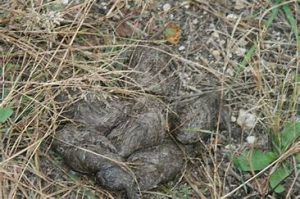
Photo: Harpers College
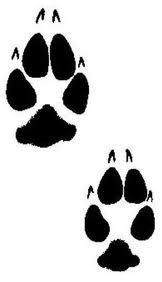
ACTIVITY
– As you can expect, we are not going to look for them… but we can look for their “sign” (evidence they are around). Sign could include tracks and scat.
– Coyote scat is usually about 2 inches long, tapered at both ends (not blunt), has a lot of hair in it.
– Coyote tracks look like dogs (and can be confused with them). Canine tracks will show claws (where cat tracks usually do not). Both dogs and coyote tracks are about 2-2.5 inches in length but differ in that the coyote track is longer, and not as wide as the dog. With coyotes you usually only see the claws on the two front toes of both the fore and hind foot, where you usually see them on all four front toes of the dog.
– Next time you hear a siren at night, listen… many times coyotes will howl at this.
AS ALWAYS
HAVE FUN AND STAY SAFE
 0
0
